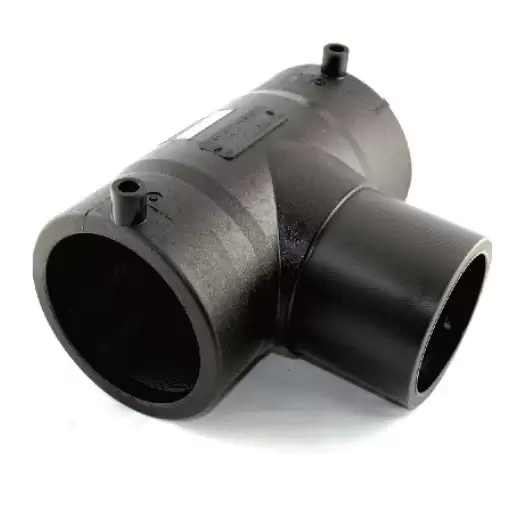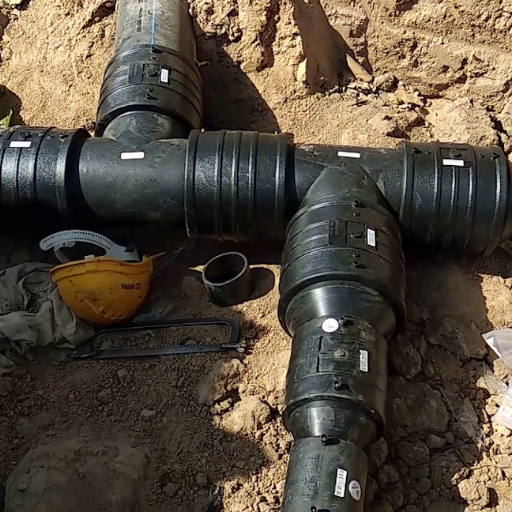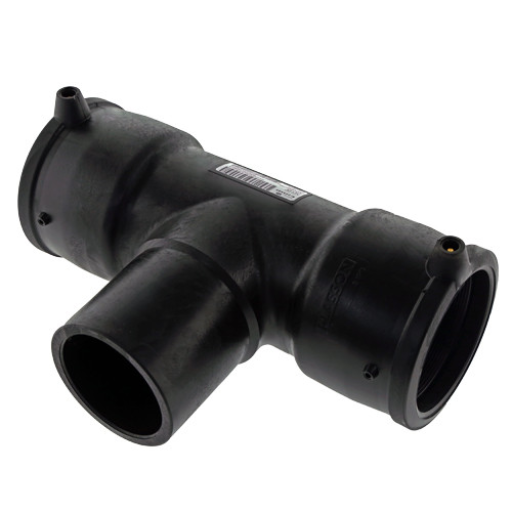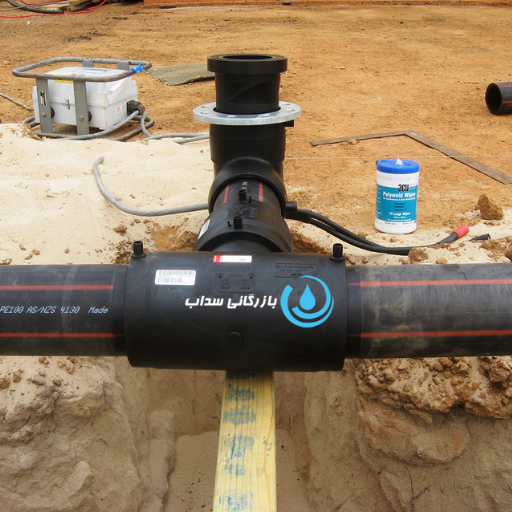In the realm of piping systems, it is essential to note that electrofusion equal tee fittings are necessary for efficient transportation and connection of fluids. These custom-made parts for easy integration link various tubes without compromising the system’s integrity and strength. This blog post will elaborate on electrofusion equal tee fittings by discussing their roles, advantages, installation process, and use cases across multiple industries. Be you a seasoned player in the world of pipe technologies or someone who has just entered this exciting field, becoming familiar with these items will prove helpful when designing and implementing an effective system.
What is an electrofusion equal tee?

Image source: https://www.acu-tech.com.au/
Electrofusion equal tees can be described as pipe fittings that join three pipes together at right angles to each other (usually 90 degrees). In the electrofusion welding method used in this type of fitting, an electric current passes through conductive coils embedded in the fitting, creating a heat that melts its inner surface, thereby fusing it onto the outer surface of pipes, making them leakproof joints. Electrofusion equal tees are widely applied in different fields, especially where gas and water distribution systems are concerned since they are strong enough to withstand environmental aspects.
Electrofusion Equal Tee Product Description
These are high-quality fittings for polyethylene pipe joinings on various fluid conveying systems, specially designed to enable the reliable joining of polyethylene pipes. The material used in making these fittings is HDPE that is long-lasting, corrosion-resistant and impervious to harmful chemicals, as well as UV radiation, hence it can be used for both underground and above ground applications. Most products come with built-in electrofusion coils that heat even during welding, leading to solid and tight connections. These fittings are made in sizes varying from 20mm up to 630mm so that they can be applied in various piping configurations. Also, some companies manufacture items following set industry standards that guarantee the safety and performance of gas, water, or drainage systems.
How does electric current aid in electro-fusion?
Electric current is required for electrofusion by flowing through conductive coils confined inside electrofusion fittings. Whereby such a current causes the heating necessary to melt both the inner surfaces of the fitting and those of the pipe being joined. As heat rises, it brings materials closer to their melting point, allowing them to fuse upon cooling, creating a robust, tight joint. The connection is consistent and reliable due to uniform heat distribution; this enhances its reliability and integrity and makes the entire piping system more durable. It is best suited for creating solid joints within various environments with diverse pressure levels due to its effectiveness and efficiency.
Advantages of using HDPE electrofusion fitting
Due to various advantageous features, HDPE electrofusion fittings are commonly preferred in piping systems. First, they provide solid and reliable joints that are uniformly made to withstand high pressures and challenging environmental conditions. Secondly, the process of electofusion enables faster installations than traditional methods since no additional materials like solvents and adhesives are needed. Moreover, these fittings exhibit superior corrosion and chemical resistance, which elongates their life span while reducing maintenance expenses within a specified period. Finally, their adaptability in accepting different pipe sizes and configurations makes them versatile for various applications, including water, gas, and waste management systems.
How are HDPE electrofusion equal tee fittings used in pipelines?

HDPE electrofusion equal tee fittings create branches on pipelines, allowing multiple pipes to be joined smoothly into a single system. These work best in fluid transportation applications such as water supply networks and gas lines. The equal tee ensures an even distribution of flow among the connected pipes for maximum efficiency during the system’s operation. To install it, the pipes should be arranged perpendicular to the main line, where electrofusion should be performed to bond it tightly without any leakage after fixing it. The latter method has seen significant progress when used in small spaces where traditional fixtures would prove more cumbersome, resulting in better overall functionality and dependability of pipeline networks.
Application in HDPE pipe systems
High-density polyethylene (HDPE) electrofusion equal tee fittings are essential in developing and maintaining HDPE pipe systems. They are used for various applications, such as municipal water supply networks, sewage and waste management systems, and industrial processes. The use of these components ensures continuous flow by minimizing chances for leakages and failures due to their strong make-up and seamless integration abilities. Moreover, the ease associated with installation through electrofusion technology enables faster project completion rates with minimum interference on existing infrastructures. Ultimately, using HDPE electrofusion fittings enhances the dependability and effectiveness of pipeline systems across diverse sectors.
Using an electrofusion processor
An electrofusion processor is necessary for joining polyethylene pipes using electrofusion fittings. One starts by cleaning the pipes’ ends so they do not contain any dirt particles. The next step involves passing a controlled electric current from the coils within an appropriate fitting through a processor to heat it to melt with a pipe. It is essential to ensure that a processor is properly calibrated because different sizes of pipes require unique fusion parameters; hence, various types of fittings have differing requirements. Moreover, most processors have embedded data monitoring features, which record details about each fusion process, ensuring that it meets industry standards. This quality assurance helps to protect the pipeline system from damage leading to leaks or failures in the future.
Installation guidelines for HDPE electrofusion equal tee fittings
Install HDPE electrofusion equal tee fittings following these essential guidelines to facilitate a proper join:
- Preparation: Commence by cutting the HDPE pipe’s ends squarely using a pipe cutter to prevent uneven surfaces. Also, remove any burrs or debris, which will provide a clean and smooth jointing surface.
- Surface Cleaning: Employ an appropriate cleaning agent to clean the pipes and fittings. This stage is vital for removing unwanted substances that interfere with fusion processes.
- Alignment and Insertion: Properly align the equal tee fitting with the prepared pipe ends. Ensure that the pipes are inserted completely into the fitting up to the required depth to achieve a strong bond.
- Setting up the Processor: Connect the electrofusion processor to the fitting. Confirm that the processor is calibrated for the particular socket size and type of fitting being used.
- Fusion Process: Start the fusion process while monitoring the duration and temperature signal as indicated by the processor. Abide by the manufacturer’s specifications for fusion parameters.
- Cooling Period: Allow the joint to cool undisturbed after completion of fusion until the manufacturer-stipulated time elapses. The period is significant in achieving optimum strength on the joint.
- Inspection: Visually inspect the joint after it has cooled down for poor fusions, such as gaps or irregularities. For system integrity, carry out pressure testing according to industry norms before putting it into service.
These guidelines should be adhered to when installing HDPE electro-fusion equal tee fittings to ensure a reliable, long-lasting pipeline connection.
Understanding the features of HDPE electrofusion equal tee

These crucial fittings are polyethylene electrofusion equal tees made with HDPE, a material that enables the connection of pipes at right angles while maintaining uniform flow. They possess the lightweight and resistance to corrosion necessary for many installations, such as water supply lines and industrial piping systems. The electrofusion procedure allows for an unbreakable joint, which decreases leakage possibilities, thus improving pipe integrity. Additionally, this design of an equal tee ensures that influences are distributed relatively across multiple directions; it is essential to achieve efficient system performance. This set of features collectively sustains various environmental conditions throughout.
The significance of pe100 material
PE100 is an exemplary pipeline-grade high-density polyethylene material recognized for its remarkable mechanical properties and durability. One significant advantage of PE100 is its high-density structure, which gives it excellent resistance to rapid crack propagation and long-term reliability under extreme circumstances. Moreover, PE100 has outstanding chemical resistance and environmental stress cracking; it is suitable for use in harsh places like industries or municipalities. It also offers lightweight benefits, ease of installation, and sustainable performance, resulting in lifecycle cost savings on the pipeline system over time. These qualities contribute significantly to the effectiveness and sustainability of infrastructure projects globally.
Why sdr11 matters
SDR11 or Standard Dimension Ratio 11 is essential in pipeline applications because it strikes a balance between the thickness of walls and their particular diameter, providing optimal strength while keeping an easily manageable weight for installation purposes. Such a ratio is significant for pipes in pressure pipe applications that must withstand high-pressure environments to preserve their integrity and safety. This additionally implies that SDR11 pipes will have thinner walls than those of other ratios, which reduces the amount of material used, resulting in cost savings for both materials and transportation. In addition, SDR11 can be used with different types of fittings and joints, thus giving it flexibility in various installation scenarios and making it an invaluable option when dealing with residential and industrial sectors.
How bar code tracking enhances fittings
Bar code tracking significantly improves the management and identification of fittings throughout pipeline systems. It enables manufacturers to take control of their inventories accurately through barcoding, thereby reducing stock management errors and speeding up the order fulfillment process. This technology allows product availability to be checked in real-time with updates on location, thus allowing faster responses to market demands. Moreover, bar code tracking improves fitting traceability through its lifecycle, leading to better compliance with industry standards and regulations. Bar codes give vital information that can enhance safety and reliability during installations, leading to better project outcomes and improved customer satisfaction if there are any recalls or quality issues.
What are the related products for an electrofusion equal tee?

Other products related to an electrofusion equal tee include electrofusion couplings, various types of electrofusion tees, and electrofusion reducers. Moreover, you will need the right fitting tools, such as the control box for electrofusion. Also, pipe supports, insulation jackets, and seals are complementary items that provide a tight and secure link without any leaks. As a whole, these products offer extensive solutions in pipeline installations, thereby enhancing strength and functionality.
Differentiating an ef equal tee from a reducing tee
A reducing tee and an EF equal tee have different functions when it comes to pipeline installation. An EF equal tee has three openings with identical diameters, allowing the connection of three sections of pipes with similar sizes that bring about uniform flow distribution. On the other hand, a reducing tee comes with one bigger inlet than two smaller outlets for changing the size within pipes while joining those with dissimilar diameters together in a pipeline system. This size difference enables more piping design flexibility while maintaining efficient flow control mechanisms. To this end, knowledge about these disparities is vital when shopping for fittings suitable for specific installation requirements.
Compared to an electrofusion coupler
Considering the distinct roles played by an electrofusion equal tee and an electrofusion coupler within a pipeline system, one needs to take note of this. It is specially made to have branches that allow three pipes of exact sizes to be joined simultaneously to ensure equal flow. On the other hand, an electrofusion coupler has been designed mainly to join two parts of the pipe that are similar in diameter while maintaining a tight seal. These fittings use the same electrofusion technique for installation, which involves heating elements and melting the embedded fusion wire, thus creating a bond with the pipe material. However, between an equal tee or a coupler, this is determined by factors like whether there is a need for branching or just extending it straightforwardly. This understanding makes it easy to select suitable connection fittings for any project.
Other HDPE fittings to consider
Various available options provide different advantages depending on specific HDPE fittings requirements.
- Electrofusion Elbows: These types are used to divert fluid flow direction along the pipeline network and are provided at various angles, such as 45 degrees and 90 degrees. Nevertheless, they deliver strong bonding and minimum resistance inside them.
- Butt Fusion Fittings: These kinds of accessories make strong permanent, tightly fixed connections when the heat fusion process brings together two pipes of matching size. Such features make these products very useful, especially when a joint with high strength is needed.
- End Caps: End caps are often necessary to close off pipelines during maintenance activities. They also protect against dirt particles, which is critical in some systems requiring frequent repairs.
When choosing HDPE fittings, fluid dynamics, pressure ratings, and project specifications must be considered to obtain optimal performance and durability.
Reference sources
-
Plastic Pipe Institute (PPI): This source offers detailed information on the principles and applications of electrofusion fittings, including equal tees. It covers durability, ease of installation, and long-term performance. Read more
-
Georg Fischer Piping Systems: This source provides insights into the design, benefits, and technical specifications of electrofusion equal tee fittings, emphasizing their reliability and efficiency in creating solid and leak-proof connections. Read more
-
Friatec by Aliaxis: This source discusses the advantages and applications of electrofusion equal tee fittings, highlighting their suitability for various piping systems, ease of use, and robust performance under different conditions. Read more
Related Articles:Specifications for E/F Equa Tee





